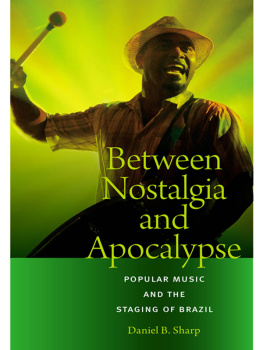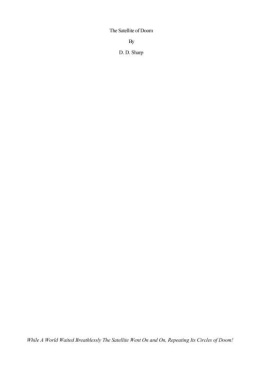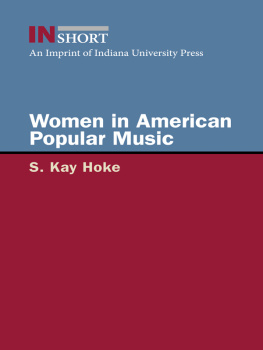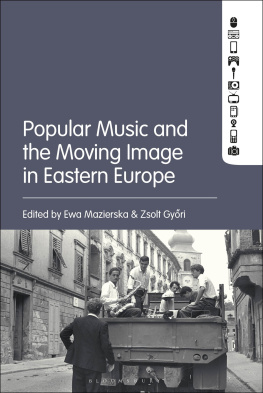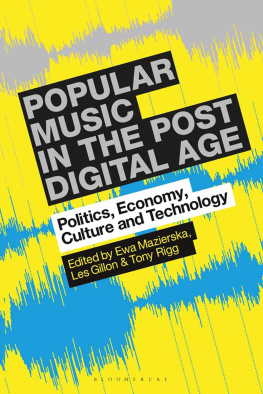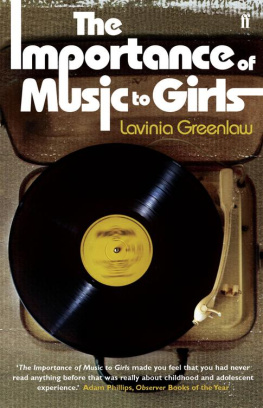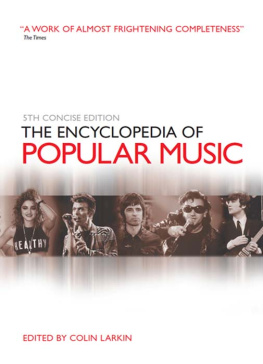Sharp - Between Nostalgia and Apocalypse: Popular Music and the Staging of Brazil (Music
Here you can read online Sharp - Between Nostalgia and Apocalypse: Popular Music and the Staging of Brazil (Music full text of the book (entire story) in english for free. Download pdf and epub, get meaning, cover and reviews about this ebook. year: 2014, publisher: Wesleyan University Press, genre: Home and family. Description of the work, (preface) as well as reviews are available. Best literature library LitArk.com created for fans of good reading and offers a wide selection of genres:
Romance novel
Science fiction
Adventure
Detective
Science
History
Home and family
Prose
Art
Politics
Computer
Non-fiction
Religion
Business
Children
Humor
Choose a favorite category and find really read worthwhile books. Enjoy immersion in the world of imagination, feel the emotions of the characters or learn something new for yourself, make an fascinating discovery.
- Book:Between Nostalgia and Apocalypse: Popular Music and the Staging of Brazil (Music
- Author:
- Publisher:Wesleyan University Press
- Genre:
- Year:2014
- Rating:3 / 5
- Favourites:Add to favourites
- Your mark:
- 60
- 1
- 2
- 3
- 4
- 5
Between Nostalgia and Apocalypse: Popular Music and the Staging of Brazil (Music: summary, description and annotation
We offer to read an annotation, description, summary or preface (depends on what the author of the book "Between Nostalgia and Apocalypse: Popular Music and the Staging of Brazil (Music" wrote himself). If you haven't found the necessary information about the book — write in the comments, we will try to find it.
Between Nostalgia and Apocalypse: Popular Music and the Staging of Brazil (Music — read online for free the complete book (whole text) full work
Below is the text of the book, divided by pages. System saving the place of the last page read, allows you to conveniently read the book "Between Nostalgia and Apocalypse: Popular Music and the Staging of Brazil (Music" online for free, without having to search again every time where you left off. Put a bookmark, and you can go to the page where you finished reading at any time.
Font size:
Interval:
Bookmark:

Between Nostalgia and Apocalypse
DANIEL B. SHARP

Between Nostalgia and Apocalypse
POPULAR MUSIC AND THE STAGING OF BRAZIL

WESLEYAN UNIVERSITY PRESS
Middletown, Connecticut
Wesleyan University Press
Middletown CT 06459
www.wesleyan.edu/wespress
2014 Daniel B. Sharp
All rights reserved
Manufactured in the United States of America
Typeset in Galliard by Integrated Publishing Solutions
Wesleyan University Press is a member of the Green Press Initiative.
The paper used in this book meets their minimum requirement for recycled paper.
Library of Congress Cataloging-in-Publication Data
Sharp, Daniel B.
Between nostalgia and apocalypse: popular music and the staging of Brazil / Daniel B. Sharp.
pages cm.(Music culture)
Includes bibliographical references and index.
ISBN 978-0-8195-7501-2 (alk. paper)ISBN 978-0-8195-7502-9
(alk. paper)ISBN 978-0-8195-7503-6
1. SambasBrazilPernambucoHistory and criticism. 2. Popular musicBrazilPernambucoHistory and criticism. 3. Popular musicSocial aspectsBrazilPernambucoHistory. I. Title.
ML3487.B77P47 2014
781.640981dc23
2014018629
5 4 3 2 1
Cover illustration: Cordel do Fogo Encantado percussionist Nego Henrique.
Photograph by the author.
Contents

Introduction

In 1938, when Dona Senhorinha Freire Barbosa was eighteen years old, the Mission of Folkloric Research visited her hometown of Tacaratu, Pernambuco, as part of a trek through Northeast Brazil to record folk music. Recordings of Dona Senhorinhainformant 490contributed to a project that profoundly shaped notions of Brazilian musical patrimony. The Mission of Folkloric Research, envisioned by the celebrated modernist writer and musicologist Mrio de Andrade, recorded in several interior towns in the states of Pernambuco and Paraba, including Tacaratu, Patos, Pombal, and Arcoverde, the epicenter of the research reported in this volume.
The team of recordists brought the discs from the rural interior of the Northeast to an archive in the more industrialized Southeast, where scholars and musicians defined Brazilian musical folklore as they compiled the tracks. Composers and performers treated the melodies from Mrio de Andrades expeditions as raw materials, forging a new framework of musical Brazilian-ness and contributing to the rise of samba as a national emblem. The combination of Luso- and Afro-Brazilian musical sensibilities came to celebrate cultural and racial mixture as a source of Brazilian national uniqueness. Andrades itineraries reinforced this particular musical mapping of culture. Within the story of samba, the Northeast serves a reservoir of tradition, while Rio de Janeiro in the Southeast serves as the site where the genre later coalesced.
The Brazilian ethnomusicologist Carlos Sandroni was pleased to find informant 490 still alive and well when his recording project retraced the route of the Mission of Folkloric Research sixty-five years later, in 2003. None of those who were recorded in 1938 had been granted access to the recordings, which had remained in So Paulo ever since the expedition returned there. His video camera rolling, Sandroni placed bulky headphones on the elderly womans head. Her eyes lit up as she heard the recording of her voice for the first time. Dona Senhorinha became nostalgic as she listened to the song. She was delighted to recognize herself and began to sing along, reminiscing about another singer on the recording, whose voice she recognized. After the song finished playing she began to remember other songs from her childhood. She jumped up and, despite her frail frame, managed to demonstrate the coco dance step.
The showing of the video of Dona Senhorinha was part of a weeklong meeting I attended in 2003 that gathered members and friends of Associao Respeita Janurio, a nonprofit organization that Sandroni founded to support traditional musicians in the region. Dona Senhorinha and others from Tacaratu were there to watch the video of her being reunited with the sound of her youthful voice. Their presence changed the emotional tenor of the event. The intellectual register of researchers progress reports was eclipsed by the strong response from the Tacaratuenses upon hearing old melodies.
Dona Senhorinhas emotional response to the recordings was to be expected. She had moved from rural Tacaratu to the capital city of Recife and thus was remembering both the place where she used to live and the era. Rural-urban migration plays a part in painting a folkloric patina on rural areas and smaller, interior towns and cities. Thus, musical fieldworkers travel to the hinterlands, where they believe traditions still endure that have faded in more urban, industrialized areas. In Brazil, with its uneven economic development, recording projects such as the Mission of Folkloric Research have represented entire regions nostalgically as repositories of heritage and folklore.
The northeastern interior region in particular has suffered extreme poverty, drought, and massive outflows of rural-urban migration in search of economic opportunities on the coast and in the Southeast. The region has been represented in popular music, literature, and film not only as a nostalgic space, but also as a space of rebellion and millenarianism, where violent bandits are celebrated for their vigilantism and maverick Catholic mystics preach the apocalypse.
Brazilians use the word saudade to express the multiple registers of nostalgia: individual and collective, universal and uniquely Brazilian. Saudade is not simply a straightforward translation of the word nostalgia, but rather an expression of a deep longing or sense of loss that has come to be conceived as a generalized affect of Brazilian-ness. The bittersweet yearning of saudade, described by Joaquim Nabuco as remembrance, love, grief and longing all at once, is often understood to be ever present in Brazilian life. The anthropologist Roberto da Matta evocatively describes saudade as an enchanted temporality that contaminates (1993, 34).
Cultural Rescue in Arcoverde, Pernambuco
After the screening of the video of Dona Senhorinha, researchers gave a presentation on musicians in Arcoverde, Pernambuco, a small commercial city on the edge of the desertlike serto interior of the state. The poet, historian, and literary scholar Micheliny Verunschk and the ethnomusicologist Cristina Barbosa described how new notions of citizenship, heritage, and tourism were scraping against older notions of folklore.
Micheliny explained that when she grew up in Arcoverde in the 1980s, it was widely considered a place without history, without memory, and without culture, a sentiment shared throughout Brazil during the fits and starts of redemocratization during the transition out of decades of military dictatorship. She expressed a desire to discover an Arcoverde where she would want to raise her own children someday. In what she described as an active reconquest of identity, Micheliny learned about the history of samba de coco from Lula Calixto, a singer and street vendor widely known as a town eccentric. Micheliny described Lula as a link to an older generation of samba de coco
Next pageFont size:
Interval:
Bookmark:
Similar books «Between Nostalgia and Apocalypse: Popular Music and the Staging of Brazil (Music»
Look at similar books to Between Nostalgia and Apocalypse: Popular Music and the Staging of Brazil (Music. We have selected literature similar in name and meaning in the hope of providing readers with more options to find new, interesting, not yet read works.
Discussion, reviews of the book Between Nostalgia and Apocalypse: Popular Music and the Staging of Brazil (Music and just readers' own opinions. Leave your comments, write what you think about the work, its meaning or the main characters. Specify what exactly you liked and what you didn't like, and why you think so.

